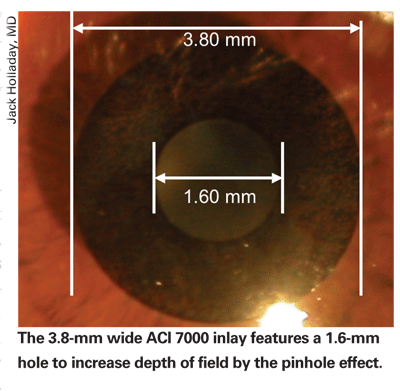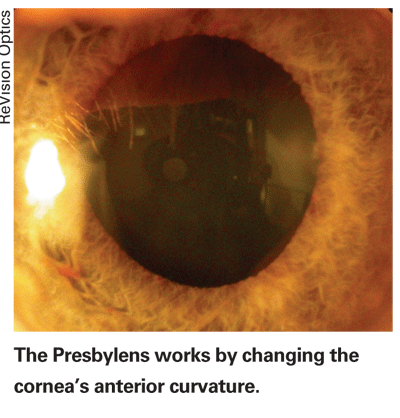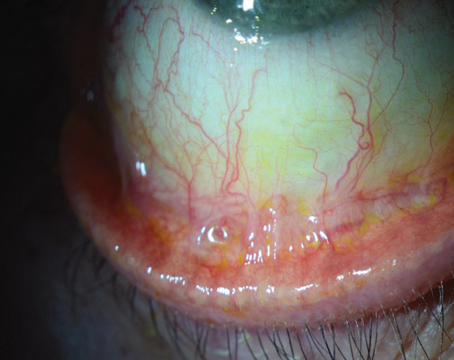Refractive surgeons often note that fear and price are the two main obstacles for patients considering refractive surgery. If that's the case, makers of novel corneal inlays for presbyopia may have at least one of these obstacles—fear—knocked since their implants are removable. The surgeons familiar with these new devices, none of them currently approved in the
The B&L/AcuFocus ACI 7000
According to ACI 7000 investigator and AcuFocus consultant Jack Holladay, MD, MSEE, FACS, of
"It works by increasing depth of field using the pinhole effect," explains Dr. Holladay. "When you make a small pinhole, the depth of field, or clarity over a given distance, is inversely proportional to the size of the hole. So, we'd expect if a patient ended up at -0.5 D or so as his final refraction, he should have between 20/20 and 20/16 vision at distance and near."
"At night, when the pupil gets larger, the inlay doesn't affect night vision, because when the pupil gets bigger it lets light come in around the inlay, so you can still see in the dark as you did before; mesopic and scotopic vision are about the same as before the inlay. That's why it's not 6 or 7 mm in size."
Of situations in which a patient has to read in low light, such as a menu in a restaurant, Dr. Holladay says, "In candlelight and other low-light situations, the pinhole effect still gives you what you need, and would probably be acceptable."
As mentioned earlier, the ACI 7000 is placed beneath a corneal flap that's usually around 160 µm thick, usually in the non-dominant eye. It's currently being implanted in emmetropic presbyopes. "The toughest part of handling it is getting it out of the case it comes in without dropping it," says Dr. Holladay. "There's a special instrument for picking it up, but once you have it and lay it down, it's pretty easy to nudge around."
In the longest-term study of the ACI 7000, from the practice of Omer Faruk Yilmaz in
Like many technologies, the ACI 7000 has gone through a couple of iterations in which the designers learned how to optimize results. "In the
Though some surgeons question the ability of an inlay to stay still beneath a flap rather than in a pocket, Dr. Holladay says migration hasn't been a problem. "When you put it down on the bed, the bed actually has collagen fiber ends that protrude upward. Some protrude through the inlay's fenestrations, which prevents it from sliding."
The ACI 7000 has currently been implanted in 200 eyes in a Phase III
AcuFocus has also made a 1.6-mm aperture device for previewing the inlay. "If you hold this preview aperture in front of a patient that has, say, some irregularities in the cornea or aberrations post-LASIK, and he says, 'If I could see like that, I'd be happy,' then you might be able to help him with the inlay." Dr. Holladay says the reason it would work in such patients would be multifactorial, but if the irregularities are mostly outside the central 1.6 mm and the patient sees better with the preview inlay, then it might help the patient see better.
ReVision Optics' Presbylens
The Presbylens is an inlay that started out as a treatment for hyperopia, when its maker, ReVision Optics, was known as Anamed. The company decided to end that trial, and has instead focused its attention on a smaller lens (the hyperopia one was a large 5-mm inlay, this is 1.5 mm) that's only 2 to 3 percent of the material volume of the hyperopia lens. "The thought is that size is its sweet spot for treating presbyopia," explains
"The interesting thing about their material is that it's the same refractive index as the cornea, so it works by creating a change in the anterior curvature of the cornea to enhance near vision, almost like LASIK in reverse," says Dr. Dishler. "With this you're adding tissue in the form of the lens, rather than ablating it away as with LASIK. It's almost like synthetic cornea from the standpoint of not interacting with the cornea but changing the anterior curvature to change the patient's vision." Dr. Dishler says it's important that the lens be refractively neutral in the cornea, because if it had a different refractive index, you could expect halos and glare.
"The inlay's maker had two different materials, one of which they used for a long time," says Dr. Dishler. "They're both proprietary plastics slightly different from one another. The first one they were using was developing some haze in a certain percentage of patients at about the three- month postop point. However, the new material that they've switched to appears to have solved that problem, and there doesn't seem to be haze formation around the lens at three to six months, which is promising."
The company is looking into two different uses for the lens. The first is to use it as a
The other application would be to use it with LASIK, either concurrently, or after LASIK in a patient who's happy with his distance vision but not with his near acuity. "The surgeon could open the LASIK flap a small amount and put the lens in," says Dr. Dishler, who adds that basic research on this is currently being done in

The Presbylens can be implanted in two ways. The first is to put it under a LASIK flap, the second involves using the IntraLase laser to make a small, 2-mm wide, 6-mm long channel through which the surgeon implants the inlay. Dr. Dishler developed the inserter that's currently used to handle the inlay. "It's almost like a blunt cannula that allows you to see the lens and release it in the eye in the proper position," he explains. If it needs to be removed for any reason, Dr. Dishler says it doesn't really scar into the eye, so it's easy to irrigate it out.
In a group of 17 patients submitted to Health
"The distance vision is reduced a little, from 20/20 to about 20/25 or at worst, 20/30," says Dr. Dishler. "But, the near vision improves from about 20/100 to 20/25 or 20/30, so you're gaining a lot of lines of near vision with not as much of a loss in distance vision."
"It seems promising," says Dr. Dishler. "It's a benign intracorneal procedure with a safety profile much better than an intraocular surgery, where a complication such as endophthalmitis can be disastrous."
Biovision's Invue
Mexico
"It's a pure refractive microlens," he explains. "It works in a way similar to the ReSTOR intraocular lens, but is in the middle of the cornea. The result is a multifocal cornea."
Dr. Sanchez Leon says he and his colleagues have performed wavefront reconstructions of visual systems using the lens, and when the pupil is 3.5 mm, "the lens physiologically acts for reading," he says. "And then, at 6 mm it's for distance." He says that the Invue doesn't modify the corneal shape, just the refraction of the light. "In one study we did in-house, we found that when we place it under 200 microns of cornea, the cornea is intact but its power isn't changed," Dr. Sanchez Leon says. The lens is 3-mm wide, 20-µm thick and made of a hydrophilic acrylic material with a small pinhole in the center.
The inlay's maker also makes the Visitome microkeratome, which is used to implant the lens. The Visitome has a blade cartridge with a knife resembling a Beaver blade on the end of the handpiece. When it oscillates, the blade creates a 3.5-mm channel rather than a flap, usually at a depth of 220 to 250 µm. The surgeon then implants the inlay through the tunnel using an inserter. Currently, surgeons implant it in the non-dominant eye, leaving the other eye to help with distance vision. It's presently designed for the emmetropic presbyope.
Dr. Sanchez Leon says the benefits of this sort of microlens include the fact that it's placed right in the middle of the cornea, depth-wise, rather than shallowly. "We have a lot of experience using 350-µm thick intracorneal ring segments that hold their place 300 µm below the surface, so this means it has less of a risk of extrusion," he says.
"A second benefit is the 3.5-mm tunnel that we implant through doesn't give much space for movement.
"Also, a third benefit is that the lens already has an injector that works well, and the lens can tolerate being manipulated by it without breaking or having a hard time moving through the channel."
So far, Dr. Sanchez Leon has performed close to 80 cases of Invue implantation, and says that patients almost always get 20/20 near vision, but lose a line of best-corrected vision, on average. "Most of the time this loss isn't noticeable because we use the non-dominant eye for implantation," he says. "But, the patient feels satisfied—he's 20/25 at distance but reads at J1. And some of them don't even lose that line of vision." He says they've also observed something interesting with patients' contrast sensitivity. "We've observed an improvement in bilateral contrast sensitivity on low-frequency mesopic and scotopic tests," he says. "We don't know why we're getting this improvement, though."
He says there are a few patients, less than 5 percent in his group of around 80, who can't get used to the multifocality and need to have the inlay removed. Around 5 percent of patients get monocular halos, but he says they seem to learn to ignore them. "Sometimes patients are upset at the early stages, but over the intermediate and long terms they don't complain at all," says Dr. Sanchez
The Invue inlay is scheduled to start a trial in the




